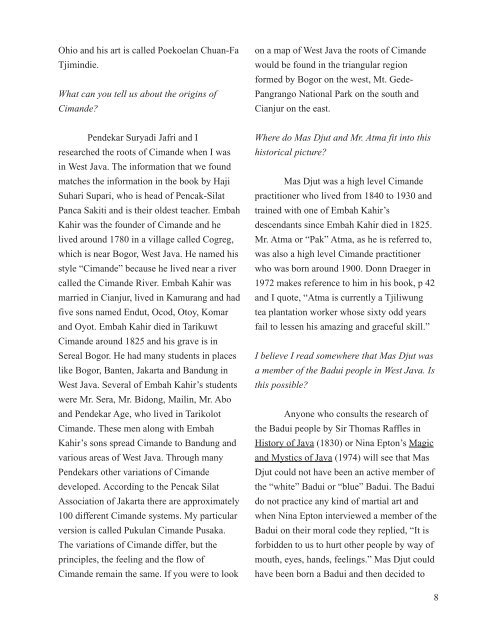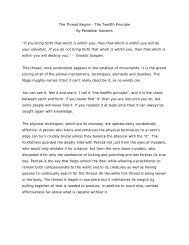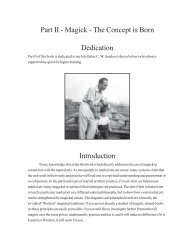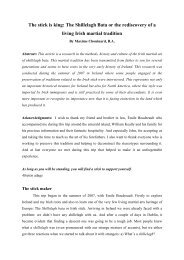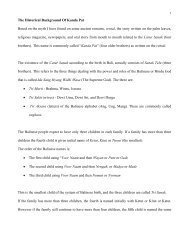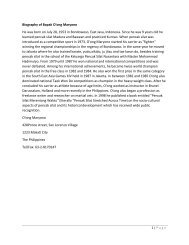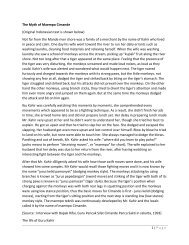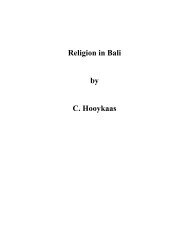Tenaga Dalam - Pukulan Cimande Pusaka
Tenaga Dalam - Pukulan Cimande Pusaka
Tenaga Dalam - Pukulan Cimande Pusaka
Create successful ePaper yourself
Turn your PDF publications into a flip-book with our unique Google optimized e-Paper software.
Ohio and his art is called Poekoelan Chuan-Fa<br />
Tjimindie.<br />
What can you tell us about the origins of<br />
<strong>Cimande</strong>?<br />
on a map of West Java the roots of <strong>Cimande</strong><br />
would be found in the triangular region<br />
formed by Bogor on the west, Mt. Gede-<br />
Pangrango National Park on the south and<br />
Cianjur on the east.<br />
Pendekar Suryadi Jafri and I<br />
researched the roots of <strong>Cimande</strong> when I was<br />
in West Java. The information that we found<br />
matches the information in the book by Haji<br />
Suhari Supari, who is head of Pencak-Silat<br />
Panca Sakiti and is their oldest teacher. Embah<br />
Kahir was the founder of <strong>Cimande</strong> and he<br />
lived around 1780 in a village called Cogreg,<br />
which is near Bogor, West Java. He named his<br />
style “<strong>Cimande</strong>” because he lived near a river<br />
called the <strong>Cimande</strong> River. Embah Kahir was<br />
married in Cianjur, lived in Kamurang and had<br />
five sons named Endut, Ocod, Otoy, Komar<br />
and Oyot. Embah Kahir died in Tarikuwt<br />
<strong>Cimande</strong> around 1825 and his grave is in<br />
Sereal Bogor. He had many students in places<br />
like Bogor, Banten, Jakarta and Bandung in<br />
West Java. Several of Embah Kahir’s students<br />
were Mr. Sera, Mr. Bidong, Mailin, Mr. Abo<br />
and Pendekar Age, who lived in Tarikolot<br />
<strong>Cimande</strong>. These men along with Embah<br />
Kahir’s sons spread <strong>Cimande</strong> to Bandung and<br />
various areas of West Java. Through many<br />
Pendekars other variations of <strong>Cimande</strong><br />
developed. According to the Pencak Silat<br />
Association of Jakarta there are approximately<br />
100 different <strong>Cimande</strong> systems. My particular<br />
version is called <strong>Pukulan</strong> <strong>Cimande</strong> <strong>Pusaka</strong>.<br />
The variations of <strong>Cimande</strong> differ, but the<br />
principles, the feeling and the flow of<br />
<strong>Cimande</strong> remain the same. If you were to look<br />
Where do Mas Djut and Mr. Atma fit into this<br />
historical picture?<br />
Mas Djut was a high level <strong>Cimande</strong><br />
practitioner who lived from 1840 to 1930 and<br />
trained with one of Embah Kahir’s<br />
descendants since Embah Kahir died in 1825.<br />
Mr. Atma or “Pak” Atma, as he is referred to,<br />
was also a high level <strong>Cimande</strong> practitioner<br />
who was born around 1900. Donn Draeger in<br />
1972 makes reference to him in his book, p 42<br />
and I quote, “Atma is currently a Tjiliwung<br />
tea plantation worker whose sixty odd years<br />
fail to lessen his amazing and graceful skill.”<br />
I believe I read somewhere that Mas Djut was<br />
a member of the Badui people in West Java. Is<br />
this possible?<br />
Anyone who consults the research of<br />
the Badui people by Sir Thomas Raffles in<br />
History of Java (1830) or Nina Epton’s Magic<br />
and Mystics of Java (1974) will see that Mas<br />
Djut could not have been an active member of<br />
the “white” Badui or “blue” Badui. The Badui<br />
do not practice any kind of martial art and<br />
when Nina Epton interviewed a member of the<br />
Badui on their moral code they replied, “It is<br />
forbidden to us to hurt other people by way of<br />
mouth, eyes, hands, feelings.” Mas Djut could<br />
have been born a Badui and then decided to<br />
8


